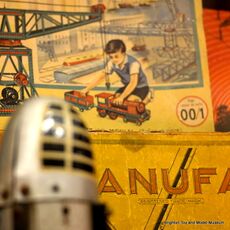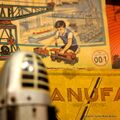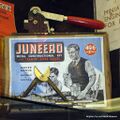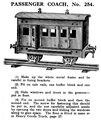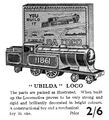Category:Metal Construction Sets (display)
| Display Area |
|---|
 |
| 06 - Metal Construction Sets (display) Arch Two |
| –– 01 02 03 04 05 06 07 08 09
10 11 12 13 14 15 16 17 18 19 20 21 22 23 24 25 26 27 28 29 30 31 32 33 34 35 36 37 38 39 40 41 42 43 44 45 46 47 48 49 50 51 52 53 54 55 –– 57 58 –– –– 61 62 63 64 65 66 67 –– –– –– 71 72 73 74 –– 76 77 78 79 80 81 82 83 84 85 86 –– –– –– |
Opposite the Meccano cabinet is a further cabinet of construction toys from other manufacturers, mostly steel, but with the occasional systems based on aluminium or wood.
History
The success of Meccano inspired a range of other metal construction toys from other manufacturers, ranging from the genuinely innovative (Juneero, Trix, the hybrid wood/metal Primus Engineering system, and the original American Erector Sets) to outright copies that usually didn't last long thanks to Meccano Ltd.'s lawyers.
A wide range of metal construction toy manufacturers appeared in the period after World War One, as war production halted and metal stock and tools became available for other purposes. While the metal toy market had previously been dominated by German companies Märklin and Bing, the dominance was broken by the war, and local companies outside Germany rushed to exploit the new availability of unrationed metal and the gap in the market left by the two German giants. For companies that perhaps didn't have a lot of toymaking experience, making construction sets probably seemed like an easy way into the market - surely all you had to do was sell packs of parts, and the customer would make the toys themselves!
A range of metal construction toy companies appeared, each trying to carve out their own particular niche in the market and produce a product with its own unique selling points.
However, Meccano had a natural monopoly of the top end of the UK market, and many of these manufacturers didn't last past the further disruption of World War Two and the shortage of metals in the immediate post-war years (partly due to the then-still-ongoing Korean War). Once the postwar UK market had settled down, it only really consisted of Meccano and Trix, whose parent companies both found themselves in financial trouble as they tried to adjust to a new toy market increasingly dominated by plastics.
Märklin
An exception was Märlkin's "Metalbaukasten" series of construction sets. If the set on display looks suspiciously like like Meccano, it's because ... it is.
Meccano-inventor Frank Hornby made the tactical mistake of setting up a German "Meccano" subsidiary just before the outbreak of World War One, and then promptly lost control of the company with the outbreak or war, after which its assets were acquired by Märklin, who then owned the rights to make a "local" version of Meccano in Germany after the war ... as long as they didn't actually call it Meccano or give the impression that they were affiliated with the UK company.
2016 display refit
The display cabinet is currently being reorganised and upgraded (Nov/Dec 2016) as part of our 25th anniversary schedule of 2016 upgrades. This will bring the display up to a similar standard as the Meccano cabinet opposite, which was upgraded in ~January.
See also:
Pages in category ‘Metal Construction Sets (display)’
The following 41 pages are in this category, out of 41 total.
C
E
J
M
P
T
Media in category ‘Metal Construction Sets (display)’
The following 14 files are in this category, out of 14 total.
- Area 06.jpg 800 × 799; 431 KB
- Dynamo (Bowman Model 839).jpg 1,800 × 752; 486 KB
- Island Station, Primus Model No 183 (PrimusCat 1923-12).jpg 3,000 × 1,713; 656 KB
- Ju52-3m clockwork model aircraft, manual, front cover (Märklin 1980).jpg 1,600 × 1,137; 369 KB
- Juneero advert Nov1939.jpg 1,606 × 2,160; 620 KB
- Juneero Set 2A.jpg 1,024 × 1,024; 444 KB
- Marklin 'constructor' motor car.jpg 1,024 × 768; 457 KB
- Mysto Erector (PopM 1913-12).jpg 584 × 454; 103 KB
- Passenger Coach, Primus Model No 254 (PrimusCat 1923-12).jpg 2,517 × 3,000; 1.27 MB
- Traction Engine, model 105 (Matador set 1).jpg 2,224 × 1,681; 1.32 MB
- Trix clockwork motor.jpg 1,024 × 768; 409 KB
- Trix Permag Electric Motor (Trixcat 1964).jpg 1,393 × 1,101; 133 KB
- Ubilda Locomotive 11861 (GamCat 1932).jpg 1,403 × 1,545; 320 KB
- Wood Station House with Metal Roof, Primus Model 302 (PrimusCat 1923-12).jpg 3,000 × 2,025; 1.04 MB
